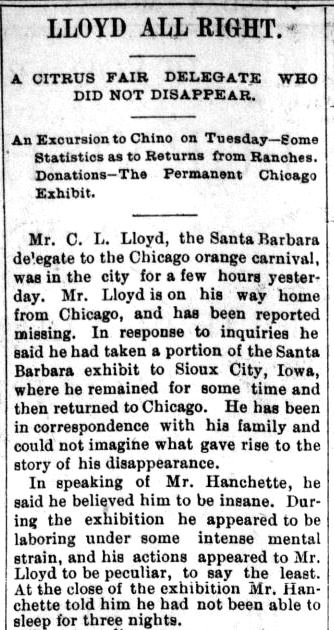This is part 4 of my series on the
mysterious disappearance of H. Jay Hanchette in 1891. My research uncovered some - interesting - things about his brother-in-law, Dr. Edgar Milton Griffith.
According to the 1900 Census, Edgar Milton Griffith was born in September 1855 in California, the son of Milton Griffith, who had died by 1880, and of Aurelia Conant Griffith, a highly
respected educator in San Francisco public schools. The 1860 and 1870 Censuses indicate he was born in 1858 or 1859, but by the 1880 Census, he is indicating that he is 25. He may have aged himself in order to graduate at age 21 from the
Medical College of the Pacific in 1876:
 |
| from the November 3, 1876, San Francisco Bulletin, page 2, via Archive of Americana |
In 1878 and 1880, he was practicing in San Francisco, according to voter registration records, the city directory, and the 1880 Census. According to an entry on his mother on pages 196-197 of Daniel
Webster
's The Bay of San Francisco: The Metropolis of the Pacific Coast and
its Suburban Cities: A History (Chicago: Lewis Pub. Co., 1892, found in the HeritageQuest Online subscription database), Edgar was a "surgeon in the United States Army, then for three years surgeon in charge of St. John's Hospital, Shanghai, China," (not St. Paul's Hospital as indicated below) with that three years ended by January 1888, with his settling in Los Angeles:
Dr. Griffith bounced between Los Angeles and San Francisco over the next few years. His 1888 voter registration puts him in Los Angeles, as does entries in the Los Angeles city directories for 1888 and 1890. However, his voter registrations for 1890, 1892, and 1896 put him back in San Francisco, as does an 1896 entry in the San Francisco city directory.
In between, though, in October 1894, the doctor gets some very negative publicity:
According to a story (excerpts above and left) in the October 13, 1894, San Francisco
Morning Call, Edgar Griffith was married at one time and had a child, but I could find no record of these anywhere else but this newspaper. (He was, however, listed as single in the 1880 Census, divorced on the 1900 Census, and widowed on 1910.)
Stories in this newspaper also indicated that the abandoned baby was adopted by the matron of the foundling home where she was taken, and
named Phoebe Hearst Henderson. Despite knowing her date of birth (October 1, 1894), I could find no further information about her, either.
As the story was picked up by other newspapers, such as in The Dalles, Oregon (below), it seemed to be embellished, turning Dr. Griffith into a monster.
As can be seen from the story above, the Los Angeles newspaper sort of remembered H. Jay Hanchette (mistakenly referred to as Charles in this article) and Dr. Griffith's relationship to his sister,
Hanchette's wife Emma. More pain for her, especially since the story was apparently exaggerated.
Despite the accusations of addiction to morphine and cocaine, it came out in court
that Griffith was actually tattooing the baby with gunpowder, apparently so it could be identified later, perhaps if the birth mother had second thoughts. On October 23, Dr. Griffith was acquitted of the charges of cruelty, and there was no news of any further charges against him.
Poor Dr. Griffith just couldn't seem to escape being involved in scandals, though. Less than a year later, in May 1895, he treated the victim in the Jennie Matthews murder case in San Francisco. A Mr. Winthrop was accused of poisoning her:
Both illustrations above, and the excerpts below, are from the May 20, 1895, San Francisco Call, page 5, via Chronicling America.
Perhaps because of the baby branding case, the police were quick to suspect Dr. Griffith of being responsible for Jennie Matthews' death, even inadvertently. However, later testimony in the case, as reported in the June 2, 1895, San Francisco Call, showed that there was enough strychnine in her stomach to kill her. However, there was not enough proof that Mr. Winthrop had given her the poison, and he was acquitted of her murder.
By 1897, Dr. Edgar M. Griffith has moved back to Los Angeles, based on listings in city directories and the 1900 and 1910 Censuses.
His name appears once more in the newspapers, in connection with the case of the wealthy Griffith Jenkins Griffith (no apparent relation) shooting his wife. Apparently the two Griffiths were friends, and G. J. "spent the day at the residence of Dr. E..M. Griffith," according to a story in the September 7, 1903 Call (page 3, via Chronicling America., below):
Edgar also provided an affadavit on Griffith's mental state at a hearing in June, 1904. Although G. J. Griffith was acquitted of attempted murder due to "alcoholic insanity," he was convicted on a lesser charge of assault with a deadly weapon, and spent two years in prison.
Dr. Edgar Milton Griffith died on September 11, 1911, in Los Angeles, according to the
Directory of Deceased American Physicians, 1804-1929 (Arthur Wayne Hafner, editor, Chicago: American Medical Association, 1993).
It's likely Dr. Griffith had nothing to do with the death of his sister,
Emma Griffith Hanchette, during surgery in San Francisco in 1898. He was living in Los Angeles at the time. However, the private hospital where it happened was
Lane Hospital, a successor to his medical school alma mater and precursor to Stanford Medical School.
© Amanda Pape - 2013 - click here to e-mail me.




















































